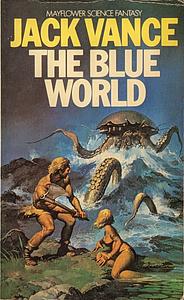Take a photo of a barcode or cover
CVIE edition
The Blue World is an longer version of Vance's novella "The Kragen". They're very similar, though the novel tells the story with a little more finesse. Essentially, Sklar Hast, one among the descendants of a crashed human ship, becomes dissatisfied and runs into trouble with the authorities. So far, standard Vance.
Sklar, however, is one of the most appealing and sympathetic of Vance's characters. Not only that, but his love interest, Meril Rohan, is unusually independent. The story itself covers how Sklar and others deal with King Kragen - a giant among the native sea life. King Kragen is clearly intelligent, and it's disappointing that Vance spends virtually no time exploring that aspect of the world - not even the history of how humans and kragen first communicated.
The story is in many ways not one of Vance's best, but it is among the most optimistic. Good things consistently happen to good people, and that's unusual in itself in a Vance story.
As always, there's great fun with language. In this case, for example, society is stratified by caste, including Hoodwinks (who, naturally, wink hoods), Advertisermen, and Swindlers.
Worth a read by anyone, and not a bad place to start with Vance. Non-serious fans won't need to read both this and the novella.
The Blue World is an longer version of Vance's novella "The Kragen". They're very similar, though the novel tells the story with a little more finesse. Essentially, Sklar Hast, one among the descendants of a crashed human ship, becomes dissatisfied and runs into trouble with the authorities. So far, standard Vance.
Sklar, however, is one of the most appealing and sympathetic of Vance's characters. Not only that, but his love interest, Meril Rohan, is unusually independent. The story itself covers how Sklar and others deal with King Kragen - a giant among the native sea life. King Kragen is clearly intelligent, and it's disappointing that Vance spends virtually no time exploring that aspect of the world - not even the history of how humans and kragen first communicated.
The story is in many ways not one of Vance's best, but it is among the most optimistic. Good things consistently happen to good people, and that's unusual in itself in a Vance story.
As always, there's great fun with language. In this case, for example, society is stratified by caste, including Hoodwinks (who, naturally, wink hoods), Advertisermen, and Swindlers.
Worth a read by anyone, and not a bad place to start with Vance. Non-serious fans won't need to read both this and the novella.
This is one of Vance's more intriguing and interesting shorter novels.
On an unnamed water world, a population of a few thousand humans, descended from a group of convicts who escaped transportation to a penal colony by hijacking the transport ship (the Ship of Space) and taking it to the water world, ingeniously struggle to survive.
Their world has no known land, and they live upon a number of floats: large lily-like pads seemingly anchored to the sea-bed—although no-one has ever dived deep enough to verify the fact. The pads provide the population with most of the raw materials necessary for housing, tools, communications, heating, etc. (Fire seems to be common, but it's never made clear how they are able to ignite them.) Other resources, including food, are obtained from fishing and the growing of edible sponges. However, even the bodies of their dead must be harvested for tool-marking materials, with human bone the hardest material available to them. In particular, they have no metal except for a few oddments left by the firsts.
In a humorous running joke, society is split into a number of castes, named after the categories of criminal on the penal transport: hoodwinks, forgers, embezzlers, larcenists, etc. The firsts have left behind a number of memoria capturing their life stories and knowledge, but the full texts are confusing to their descendants due to a lack of context. Indeed, they do not even realize that their forebears were criminals. Much of the wisdom from the memoria are captured in a smaller set of widely taught analects.
What would be an already difficult challenge is made harder by the presence of the kragen—a large indigenous species of semi-intelligent aquatic life that periodically raid the floats' lagoons for food. One particular kragen, King Kragen has grown, metaphorically and physically, to special prominence. Its covenant with the humans, as defined by a cast known as the intercessors, is that it will protect the humans from other the other kragen in return for being able to exploit their food resources. Originally just slightly larger than the other kragen, it's special treatment has allowed it to grow many times bigger over the 150 years or more of its association with the humans. It is now a monster of terrifying power, capable of destroying entire floats when angered.
What Vance does excellently is to both explain the mechanism by which King Kragen reached his present dominance, and the divided human reactions to it.
On the one side, there is Sklar Hast—a hoodwinker (operating one of the chain of communication towers used to send messages between the floats) who has grown tired of seeing his food eaten by King Kragen, as well as the smaller kragen that King Kragen appears too slow to deal with. He doubts that the firsts would have escaped persecution by their oppressors (as they see the firsts' predicament) only to become the subjects of a fish.
On the other side are the intercessors including Sklar Hast's rival, Semm Voiderveg. Their role as intermediaries between the humans and King Kragen Vance equates to a kind of priesthood. They worship King Kragen and view any threats against him as almost blasphemous. Similarly, threats against the lesser kragen risks King Kragen's displeasure, since disposing of them is his sole right. The intercessors' stance is is partly out of fear for damage that an aggrieved King Kragen can wrought, but also partly because their elevated social status means that they do not have to work as hard as the other castes, and that their life of leisure would disappear if King Kragen was no more.
The plot is neither elaborate nor unpredictable, yet the detailed social structures, the ingenious use of materials, and the depths of the complex characters all make this a wonderful read.
Sklar Hast is a particularly ruthless protagonist, and one wonders whether a different personality would have helped resolve the population's problems in a more peaceful, unified manner. That he is such a difficult character just makes for a more interesting story.
All in all, a tale I can highly recommend.
On an unnamed water world, a population of a few thousand humans, descended from a group of convicts who escaped transportation to a penal colony by hijacking the transport ship (the Ship of Space) and taking it to the water world, ingeniously struggle to survive.
Their world has no known land, and they live upon a number of floats: large lily-like pads seemingly anchored to the sea-bed—although no-one has ever dived deep enough to verify the fact. The pads provide the population with most of the raw materials necessary for housing, tools, communications, heating, etc. (Fire seems to be common, but it's never made clear how they are able to ignite them.) Other resources, including food, are obtained from fishing and the growing of edible sponges. However, even the bodies of their dead must be harvested for tool-marking materials, with human bone the hardest material available to them. In particular, they have no metal except for a few oddments left by the firsts.
In a humorous running joke, society is split into a number of castes, named after the categories of criminal on the penal transport: hoodwinks, forgers, embezzlers, larcenists, etc. The firsts have left behind a number of memoria capturing their life stories and knowledge, but the full texts are confusing to their descendants due to a lack of context. Indeed, they do not even realize that their forebears were criminals. Much of the wisdom from the memoria are captured in a smaller set of widely taught analects.
What would be an already difficult challenge is made harder by the presence of the kragen—a large indigenous species of semi-intelligent aquatic life that periodically raid the floats' lagoons for food. One particular kragen, King Kragen has grown, metaphorically and physically, to special prominence. Its covenant with the humans, as defined by a cast known as the intercessors, is that it will protect the humans from other the other kragen in return for being able to exploit their food resources. Originally just slightly larger than the other kragen, it's special treatment has allowed it to grow many times bigger over the 150 years or more of its association with the humans. It is now a monster of terrifying power, capable of destroying entire floats when angered.
What Vance does excellently is to both explain the mechanism by which King Kragen reached his present dominance, and the divided human reactions to it.
On the one side, there is Sklar Hast—a hoodwinker (operating one of the chain of communication towers used to send messages between the floats) who has grown tired of seeing his food eaten by King Kragen, as well as the smaller kragen that King Kragen appears too slow to deal with. He doubts that the firsts would have escaped persecution by their oppressors (as they see the firsts' predicament) only to become the subjects of a fish.
On the other side are the intercessors including Sklar Hast's rival, Semm Voiderveg. Their role as intermediaries between the humans and King Kragen Vance equates to a kind of priesthood. They worship King Kragen and view any threats against him as almost blasphemous. Similarly, threats against the lesser kragen risks King Kragen's displeasure, since disposing of them is his sole right. The intercessors' stance is is partly out of fear for damage that an aggrieved King Kragen can wrought, but also partly because their elevated social status means that they do not have to work as hard as the other castes, and that their life of leisure would disappear if King Kragen was no more.
The plot is neither elaborate nor unpredictable, yet the detailed social structures, the ingenious use of materials, and the depths of the complex characters all make this a wonderful read.
Sklar Hast is a particularly ruthless protagonist, and one wonders whether a different personality would have helped resolve the population's problems in a more peaceful, unified manner. That he is such a difficult character just makes for a more interesting story.
All in all, a tale I can highly recommend.
A fun book set in a fantastic setting that never really lives up to its potential. Basically it's a bunch of people living on an ocean worshipping/fighting a kraken (or kragen as they are called in the book). The setup is great, and there's some very clever world building, but the story itself never really amounts to anything.
It actually felt like the first third of a longer book, or the start of a series. I wasn't sure the book was actually going to end until the very last chapter when suddenly everything was tied up in a neat little bow.
I enjoyed the book for the most part, but it's a hard book to recommend unless you enjoy pulpy sci-fi.
It actually felt like the first third of a longer book, or the start of a series. I wasn't sure the book was actually going to end until the very last chapter when suddenly everything was tied up in a neat little bow.
I enjoyed the book for the most part, but it's a hard book to recommend unless you enjoy pulpy sci-fi.
Encontré este librito en una mesa de saldos y me lo traje por una recomendación que me hicieron del autor. El libro no decepciona, la historia es atrapante y los personajes están muy bien hechos. El final me pareció corto, hubiese sido necesario un epílogo o algo para aclarar cómo terminaron las cosas.
3,7/5 itkos
3,7/5 itkos
It takes place on a world totally covered in water. All their tools and supplies come from biological resources. Most material is made from plants and plant-like animals (like sponges). The hardest substance they have is bone. There is no metal (until they start bleeding themselves to get to the iron in their blood - ew) and communication is done by big semaphore towers.
This is true science fiction - a whole lot of science and not a terrible amount of story. Its saving grace is that its short and tight, and the science isn't flooding, just distracting. And there is story here to latch onto - the conflict of religion and science. A man dares to question why things must be as they are, and the priests don't much care for that. I like those kinds of stories (although there is some irrelevant stuff in the beginning that makes me question its relevance therein, and the romance is nil).
This is true science fiction - a whole lot of science and not a terrible amount of story. Its saving grace is that its short and tight, and the science isn't flooding, just distracting. And there is story here to latch onto - the conflict of religion and science. A man dares to question why things must be as they are, and the priests don't much care for that. I like those kinds of stories (although there is some irrelevant stuff in the beginning that makes me question its relevance therein, and the romance is nil).
adventurous
fast-paced
adventurous
dark
funny
medium-paced
Plot or Character Driven:
A mix
Strong character development:
Yes
Loveable characters:
No
Diverse cast of characters:
Yes
Flaws of characters a main focus:
Yes
I enjoyed it! Three stars, but take my rubric in mind and this is a good rating for some sci-fi. I really like Vance, and while this isn’t one of his top few books, it’s a lot of fun and very Vancian. It was a good way to spend a couple hours.
adventurous
dark
tense
fast-paced
Plot or Character Driven:
Plot
Strong character development:
No
Loveable characters:
Complicated
Diverse cast of characters:
No
Flaws of characters a main focus:
No







